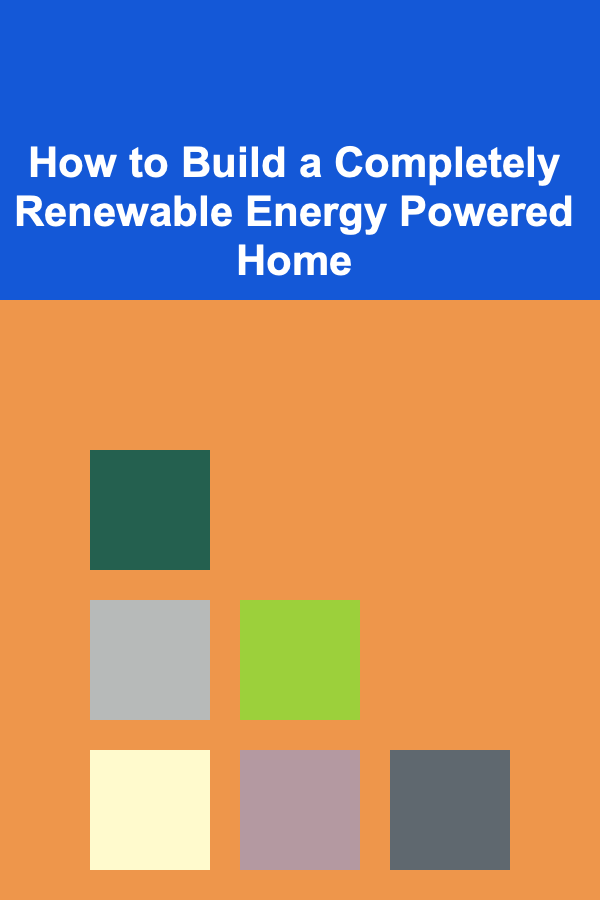
How to Build a Completely Renewable Energy Powered Home
ebook include PDF & Audio bundle (Micro Guide)
$12.99$9.99
Limited Time Offer! Order within the next:

In recent years, the world has seen a major shift towards sustainability and the adoption of renewable energy sources. As concerns about climate change and environmental degradation continue to rise, many homeowners are turning to renewable energy to power their homes in an effort to reduce their carbon footprint and lower their reliance on fossil fuels. Building a completely renewable energy-powered home is a powerful way to embrace sustainability and make a positive impact on the environment.
This article explores the process of building a fully renewable energy-powered home, focusing on the key components, technologies, and strategies that make such a home feasible. From solar panels and wind turbines to energy-efficient construction methods and smart home systems, we will guide you through the steps required to create a home that generates and uses only renewable energy.
Assessing Your Energy Needs
Before diving into the specifics of renewable energy technologies, it's essential to first assess the energy needs of your home. Every household consumes a different amount of energy depending on factors such as the number of people living in the house, the size of the home, the climate, and the types of appliances and devices used.
How to Calculate Energy Consumption
To understand how much energy you will need, consider the following steps:
- Evaluate Monthly Electricity Usage: Look at your monthly electricity bill to determine how much energy you consume on average. This is usually measured in kilowatt-hours (kWh).
- Identify Energy-Intensive Appliances: Take note of appliances and devices that use a significant amount of electricity, such as air conditioners, refrigerators, water heaters, and washing machines.
- Consider Future Needs: If you plan on adding more people to the household or increasing the number of devices (e.g., electric cars, home automation systems), factor these into your energy calculation.
- Energy Efficiency Goals: Decide whether you want to meet your energy needs entirely with renewable energy or if you want to implement energy-saving technologies alongside renewable energy generation.
Once you have a clear understanding of your energy consumption, you can begin planning how to meet these needs using renewable energy sources.
Choosing the Right Renewable Energy Sources
There are several renewable energy technologies available to homeowners today. The most common options include solar power, wind power, and geothermal energy. Depending on your location, budget, and energy needs, you may choose to rely on one or a combination of these energy sources.
Solar Power: The Most Popular Option
Solar energy is by far the most widely used renewable energy source for residential homes. Solar panels, or photovoltaic (PV) panels, convert sunlight into electricity through the photovoltaic effect. Solar power systems can be installed on the roof of your home or on the ground if you have sufficient space.
Benefits of Solar Power
- Abundant Resource: Solar energy is plentiful and available in most parts of the world.
- Low Maintenance: Solar panels require minimal maintenance after installation, with most systems only needing periodic cleaning and inspection.
- Long Lifespan: Solar panels typically last for 25 years or more.
- Scalable: You can install a solar system that fits your specific energy needs, from small-scale residential setups to larger, more powerful systems.
Considerations for Solar Power
- Location: The effectiveness of solar panels depends on the amount of sunlight your location receives. If you live in an area with frequent cloud cover or long winters, solar power may not be your sole energy source.
- Upfront Costs: While the cost of solar panels has significantly decreased in recent years, the initial installation cost can still be high. However, many governments offer incentives or tax credits to reduce these costs.
Wind Power: Harnessing the Wind
Wind turbines are another renewable energy option for homeowners who live in areas with consistent and strong wind. A wind turbine works by using the kinetic energy of the wind to turn blades that generate electricity.
Benefits of Wind Power
- High Efficiency: Wind power is one of the most efficient renewable energy sources, especially in areas with high average wind speeds.
- Sustainable: Wind is a renewable resource that will not deplete over time.
- Off-Grid Potential: Wind turbines can provide power to homes in remote locations where grid access is unavailable.
Considerations for Wind Power
- Location: Wind turbines are only effective in areas with consistent wind speeds of at least 9 miles per hour (14 kilometers per hour). Be sure to assess local wind conditions before investing in a wind turbine.
- Space Requirements: Wind turbines require significant space and need to be placed at a distance from other structures to ensure they operate efficiently.
- Noise: While modern wind turbines are designed to minimize noise, they can still create a certain level of sound, which may be a consideration in residential areas.
Geothermal Energy: Using the Earth's Heat
Geothermal energy systems take advantage of the heat stored beneath the Earth's surface. These systems work by extracting heat from the ground to provide heating, cooling, and hot water for your home.
Benefits of Geothermal Energy
- Efficient Heating and Cooling: Geothermal systems provide consistent and efficient heating and cooling, which can reduce energy consumption for temperature control.
- Low Operating Costs: Once installed, geothermal systems have low operating costs and require minimal maintenance.
- Sustainable: Geothermal energy is considered a highly sustainable source of power, with a small environmental footprint.
Considerations for Geothermal Energy
- Installation Costs: Geothermal systems can be expensive to install, particularly the ground loop systems, which require digging trenches or drilling wells.
- Space: You will need sufficient land for the installation of a geothermal system, especially for larger residential systems.
Combining Renewable Energy Sources
In many cases, homeowners opt to combine different renewable energy sources to ensure a reliable and consistent supply of power. For example, you might install both solar panels and a wind turbine to take advantage of different weather conditions. A combination of energy sources can help ensure that you have enough power to meet your needs, even when one source is not performing optimally.
Energy Storage: Ensuring Reliability
One of the challenges of using renewable energy is that it is intermittent---solar power only works when the sun is shining, and wind power only works when there is wind. To overcome this challenge, homeowners can use energy storage systems to store excess energy generated during the day for use at night or during periods of low energy production.
Batteries
The most common form of energy storage is using batteries, specifically lithium-ion batteries. These batteries can store energy generated by solar panels or wind turbines and provide power when needed.
Benefits of Energy Storage
- Energy Independence: Storing energy allows you to become more independent from the grid and reduces your reliance on utility companies.
- Backup Power: In the event of a power outage, a storage system can provide backup power to keep your home running.
- Maximize Efficiency: Storing excess energy allows you to use it when renewable sources are not producing enough power.
Considerations for Batteries
- Cost: The cost of battery storage systems can be significant, though prices are decreasing as the technology improves.
- Battery Life: While lithium-ion batteries have a long lifespan, they do degrade over time and may need to be replaced after a decade or so.
- Storage Capacity: The size of your battery system will depend on your energy needs. Larger systems can store more energy but come with a higher price tag.
Smart Home Integration
Integrating your renewable energy systems with smart home technology can further enhance efficiency and convenience. A smart home system can automatically manage your energy usage by adjusting heating, cooling, lighting, and appliance operation based on energy availability and consumption patterns. For example, smart thermostats can optimize heating and cooling based on the energy stored in your battery, ensuring that you use the least amount of energy possible during peak hours.
Implementing Energy-Efficient Building Practices
Building a home that is entirely powered by renewable energy goes beyond just installing solar panels or wind turbines. It also involves using energy-efficient construction techniques and materials to reduce the overall energy demand of your home.
Insulation
Good insulation is essential for keeping your home comfortable while minimizing the need for heating and cooling. Proper insulation helps maintain a stable indoor temperature, reducing your reliance on energy-hungry HVAC systems.
High-Efficiency Appliances
Replacing traditional appliances with energy-efficient models can significantly reduce your overall energy consumption. Look for appliances with the Energy Star label, which indicates that they meet high efficiency standards.
Passive Design Principles
Passive design principles, such as orienting your home to maximize natural light, can reduce your reliance on artificial lighting and heating. Properly placed windows and shading can help your home stay cool in the summer and warm in the winter without excessive energy use.
Smart Energy Management
A smart energy management system can help optimize the use of renewable energy in your home. These systems can automatically control lighting, heating, cooling, and appliance usage based on real-time energy data and environmental conditions.
Building a Fully Renewable Home: Step-by-Step Guide
Building a completely renewable energy-powered home is a significant undertaking, but with the right planning and resources, it is entirely achievable. Here's a step-by-step guide to help you get started:
Step 1: Plan and Design
Start by working with an architect or builder who is experienced in sustainable construction. Together, you can design a home that maximizes energy efficiency while incorporating renewable energy technologies.
Step 2: Choose Your Renewable Energy Systems
Based on your energy needs and location, select the renewable energy systems that are right for your home. Solar power, wind power, and geothermal energy are all viable options, and combining them can ensure a reliable power supply.
Step 3: Install Energy Storage
To ensure that you have power during periods when renewable energy production is low, install an energy storage system such as lithium-ion batteries. This will allow you to store excess energy for later use.
Step 4: Focus on Energy Efficiency
Incorporate energy-efficient building materials and appliances into your design to reduce your overall energy consumption. Insulation, high-efficiency windows, and passive solar design can make a significant difference in your energy needs.
Step 5: Monitor and Adjust
Once your home is complete, monitor your energy usage and renewable energy production. With smart home technology, you can make adjustments to optimize energy efficiency and ensure that you are always using renewable power.
Conclusion
Building a completely renewable energy-powered home is a challenging but rewarding endeavor. By carefully assessing your energy needs, selecting the right renewable energy sources, incorporating energy storage, and implementing energy-efficient building practices, you can create a home that generates all the power it needs sustainably and efficiently. With continued advancements in renewable energy technologies, the dream of living in a fully self-sustaining home is becoming more and more accessible. By making the switch to renewable energy, you are not only reducing your environmental impact but also contributing to a cleaner, more sustainable future for generations to come.
Other Products

Creating AI-Powered Courses to Earn Passive Income from Deep Learning
Read More
How to Add a Walk-In Closet to Your Bedroom Renovation
Read More
How to Decorate Your Home for the Holidays Without Overwhelming the Space
Read More
How to Make the Most of Under-Bed Storage for Small Spaces
Read More
How to Plan a Cocktail Party with a Classy Touch
Read More